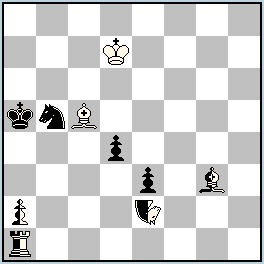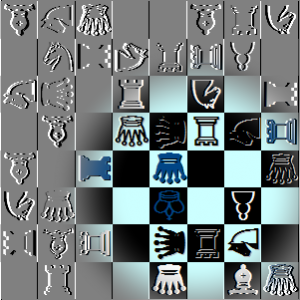|
|
Original Problems (page 100)Original fairy problems published during 2012 will participate in the informal tourney JF-2012. The site is mostly about fairies, but h# and s# are also welcomed for publication! Please send your problems to my e-mail: julia@juliasfairies.com Go to →List of Problems; →Page 99 ; →Page 101 |
No.165 – h#2 by Julia Vysotska – This is actually my first Take & Make problem. I like it myself, and I hope I’m not the only one! 🙂 (JV)
Definitions:
Take & Make: Having captured, a unit must immediately, as part of its move, play a non-capturing move in imitation of the captured unit from the capture-square. If no such move is available, the capture is illegal. Promotion by capture occurs only when a pawn arrives on the promotion rank as the result of a take&make move. Checks are as in normal chess: after the notional capture of the checked K, the checking unit does not move away from the K’s square.
Nightrider(N): A Rider along a straight line on squares lying a Knight`s move away from each other.

The diagrams are made on WinChloe and its Echecs font is used for Logo design



Good first problem ! But it would have been nice if nPa2 moved in both solutions !
Thanks! I also wanted to have pawn’s move in the both solutions. But couldn’t find a way to do it. On another hand, even without it I’ve kept the main thematic in the both solutions, and on the same time have made the problem much more complicated for solving (I believe!).
My idea of possible improvement was to use camelrider instead of nightrider to allow movement of a-pawn in both directions, to show his true neutral character. But it turned out to be quite difficult to concentrate the play solely to access to final capture squares as B+CR both use only half of squares normally, so that I had to employ additional motif of guarding a flight. Also forcing the move order was difficult.
Nevertheless, it seems possible as follows:
[img]http://www.ankona.ch/100039.png[/img]
Take & Make
h#2 2.1.1.1
1.nCRa2*d1-c3 nBc2-b3 2.nPa3-a2 nPa2*b3-g8=nCR #
1.nBc2*d1-e3 nPa3-a4 2.nCRa2-b5 + nPa4*b5-c8=nB #
Surely it can be improved, further there are some non-analogous motifs that can be understood as variety in unity.
Juraj, thanks for your idea! Yes, you’re right – a play of neutral pawn is better now, but seems like I can’t improve the other things myself. Have you tried more?
Honestly, for me even my version technically was not easy, although in my scheme I didn’t have a problem with move order.
I have tried not so little to get the present position. I think the possible improvement is in the change of wS, either only location or also piece type, to avoid so many black pawns. But I did not try any longer after submitting the position.
No. 165 nPa2 only prevents dualistic promotion into wQ/wB which would be possible in case of wPa2.
nBg3 is necessary only in one solution when both Black and White move it (1…nBxf4-d5 2.nBb3), in the other solution wBg3 is enough (so Phenix is half-convincing).
black Ne2 would be enough in both solutions, so the neutral nature of N gives a completely artificial Phenix effect.
Thanks, Nikola! I coudn’t have any objections to the facts you’ve pointed on. But the question is if it is a big weakness and what would be better or worse.
1) Yes, nPa2 just prevents the dual. Still, it does it, and I see no ways to make it differently in this scheme. (maybe if I’ve used f.i. Bishop-Lion instead of B the pawn could be white). A nice solution for the pawn would be moves back and forward, as in Juraj’s version, but there’re other weaknesses.
2) black Ne2 would work here without problems, the problem would be C+ as well. But in such case 2 solutions wouldn’t be so homogeneous. Also, neutral piece gives some complications for solvers, as a behavior of bN would be very predictable.
3) Well, yes, I also like more the 2nd solution where nB does the both – white and black moves. But I can’t have it in another one, unfortunately… Maybe in case of some more half-move. But it would be really complicated I believe.
4) Myself I’d point more on nRa1! It is neutral really only to stop some cooks! Usually I don’t use neutral pieces in such cases, but this problem seemed to me so “neutral” already, that I thought that it is not a big thing to have one more neutral piece.
I guess that here I can get very opposite views. And I like to hear these views. Sometimes it is not easy to make one rule for every case. And in this problem I see some pluses and minuses as well.
Long time ago Juraj has written in one comment to my problem ( https://juliasfairies.com/problems/page-2/#comment-85 ) about using fairy pieces, neutral pieces.
I see more excuses for myself for using neutral pieces here to compare with neutral Knight we had discussed there.
Anyway, without these neutral pieces this problem wouldn’t exist at all! I mean, by this scheme. But I’d like to see other possible versions if anyone has! It is always interesting to see possible improvement.
Due to my little experience with fairies, I am not qualified to evaluate specific fairy issues. So I try to grasp the facts and consider them within the general frame of chess composition (as I see it).
I mentioned some facts but I actually did not comment how much is some fairy element justified by the play. Still, I am interested how these facts would be interpreted by experienced fairy composers.
Generally, I think that fully convincing Phenix should have two features:
-the original piece has a specific thematic function when it is not captured (that function can not have any other piece)
-the promoted piece (Phenix) has a specific function which can’t have any other piece
Only one feature would make half-convincing Phenix and the lack of both features may give only an artificial Phenix. nNe2 is not specifically necessary in the beginning as well as in the end.
You did not claim the presence of theme Phenix and my comment was actually not about what is the content, but about how complex the thematical content hypothetically might be (formally there is Phenix in your problem).
(One fact about Juraj’s example, black CR would be enough for one solution. A comment about Phenix would be senseless here, since there’s no such theme present, even formally.)
Well, I may try to comment some specifically fairy elements, within the range of my modest experience.
Take & Make condition is interestingly and skilfully applied for white promotions and for 1st black/white moves (a pleasing variety), respectively in 2 phases. Your first use of T&M is very fine.
The use of neutral pieces doesn’t look as essential. Only nBg3 is thematical in (only) one phase. nRa1 and nPa2 only prevent cooks/duals and nNe2 is an illusion. “Reciprocal sacrifice-promotion” (as well as Phenix) may sound great but I don’t find it enough convincing (crucially because of the illusional nNe2).
Anyway, I like that Take & Make component, qite enough to congratulate for the idea.
Nikola, I like your analysis and explanations to your points! Thank you for everything! Same as you, I’d like to hear the experts’ views.
About Phenix – I did not claim the presence of it (as you have said) as I didn’t know about it! 🙂
I just composed it the way I liked to see. So, you’ve taught me a new theme, thanks!
http://pdb.dieschwalbe.de/search.jsp?expression=PROBID=%27P1308940%27